MERCEDES-BENZ G-CLASS SUV 2016 Service Manual
Manufacturer: MERCEDES-BENZ, Model Year: 2016, Model line: G-CLASS SUV, Model: MERCEDES-BENZ G-CLASS SUV 2016Pages: 261, PDF Size: 6.01 MB
Page 41 of 261
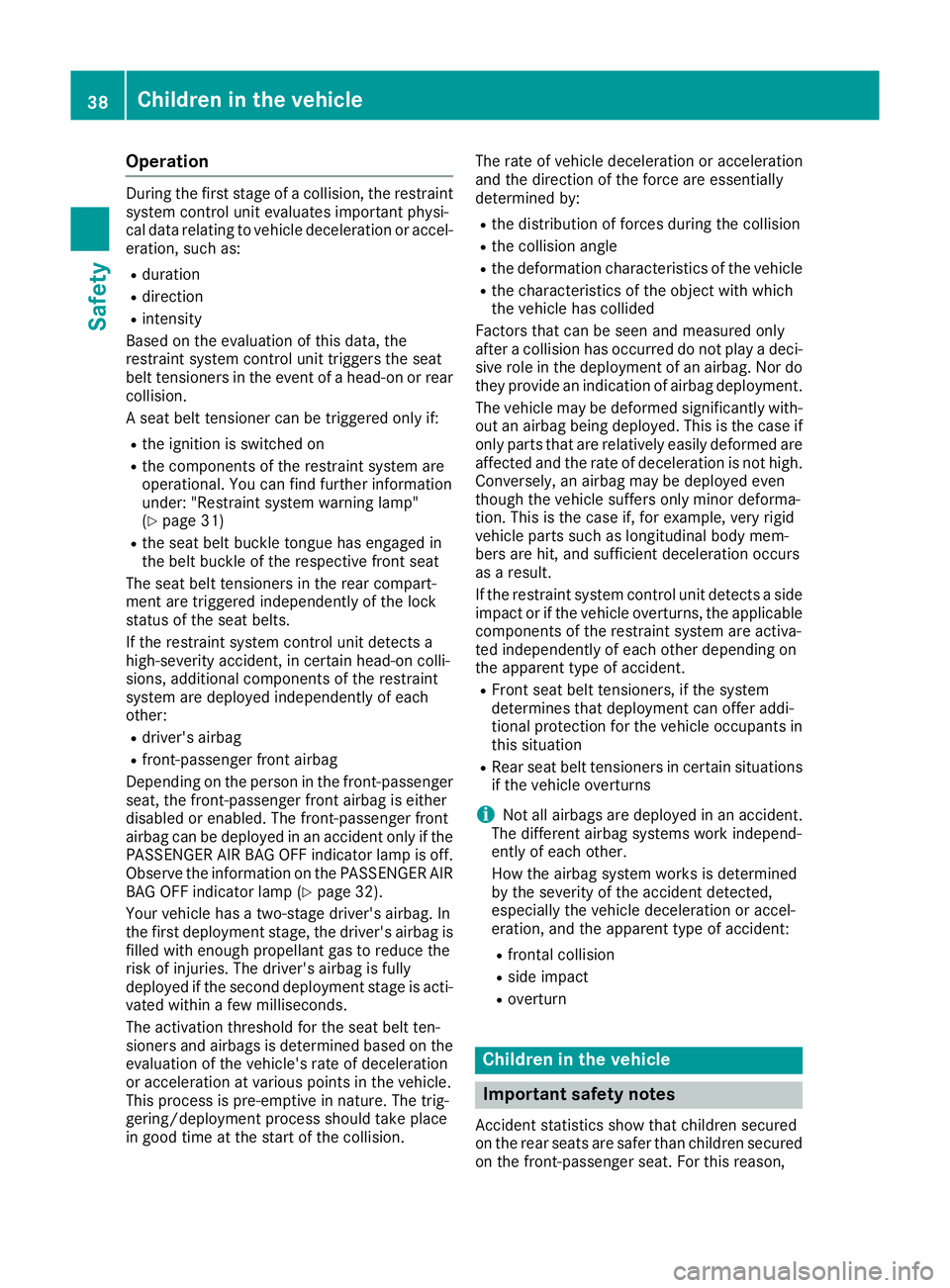
Operation
During th
efirst stage of acollision, the restraint
system contro lunite valuate simportant physi-
cal data relating to vehicl edeceleratio noraccel-
eration, such as:
R duration
R direction
R intensity
Based on the evaluation of thi sdata, the
restraint system contro lunitt riggers the seat
belt tensioners in the event of ahead-o norrear
collision.
As eatb eltt ensioner can be triggered onl yif:
R the ignition is switched on
R the components of the restraint system are
operational .You can find furthe rinformation
under: "Restraint system warning lamp"
(Y page 31)
R the sea tbeltb uckle tongue ha sengaged in
the belt buckle of the respectiv efront seat
The sea tbeltt ensioners in the rea rcompart-
ment ar etriggered independentl yofthe lock
status of the sea tbelts.
If the restraint system contro lunitd etects a
high-severity accident, in certain head-on colli-
sions, additional components of the restraint
system ar edeployed independentl yofeach
other:
R driver's airbag
R front-passenge rfront airbag
Depending on the perso ninthe front-passenger
seat, the front-passenge rfront airba giseither
disabled or enabled .The front-passenge rfront
airba gcan be deployed in an accident onl yifthe
PASSENGER AIR BAG OFF indicator lamp is off.
Observe the informatio nonthe PASSENGER AIR
BAG OFF indicator lamp (Y page 32).
Your vehicl ehasatwo-stage driver's airbag. In
the first deployment stage ,the driver's airba gis
fille dwithe noug hpropellant ga storeduce the
ris kofi njuries. The driver's airba gisfully
deployed if the second deployment stage is acti- vated withi nafew milliseconds.
The activatio nthreshold for the sea tbeltt en-
sioners and airbags is determine dbased on the
evaluation of the vehicle's rate of deceleration
or acceleratio natvarious points in the vehicle.
Thi sp roces sispre-emptive in nature. The trig-
gering/deployment proces sshoul dtake place
in good time at the start of the collision. Th
er ate of vehicle deceleration or acceleration
and the direction of the force are essentially
determined by:
R the distribution of forces during the collision
R the collision angle
R the deformation characteristics of the vehicle
R the characteristics of the object with which
the vehicle has collided
Factors that can be seen and measured only
after acollision has occurred do not play adeci-
sive role in the deployment of an airbag. Nor do
they provide an indication of airbag deployment.
The vehicle may be deformed significantly with-
out an airbag being deployed. This is the case if only parts that are relatively easily deformed are
affected and the rate of deceleration is not high. Conversely, an airbag may be deployed even
though the vehicle suffers only minor deforma-
tion. This is the case if, for example, very rigid
vehicle parts such as longitudinal body mem-
bers are hit, and sufficient deceleration occurs
as aresult.
If the restraint system control unit detect saside
impact or if the vehicle overturns, the applicable components of the restraint system are activa-
ted independently of each other depending on
the apparent type of accident.
R Fronts eat belt tensioners, if the system
determines that deployment can offer addi-
tional protection for the vehicle occupant sin
this situation
R Rear seat belt tensioners in certain situations
if the vehicle overturns
i Not all airbags are deployed in an accident.
The different airbag systems work independ-
ently of each other.
How the airbag system works is determined
by the severity of the accident detected,
especially the vehicle deceleration or accel-
eration, and the apparent type of accident:
R frontal collision
R side impact
R overturn Childr
en in th evehicle Important safety notes
Acciden tstatistics sho wthatc hildren secured
on th erear seat sare safer than children secured
on th efront-pa ssenger seat .For this reason, 38
Children in th
evehicleSafety
Page 42 of 261
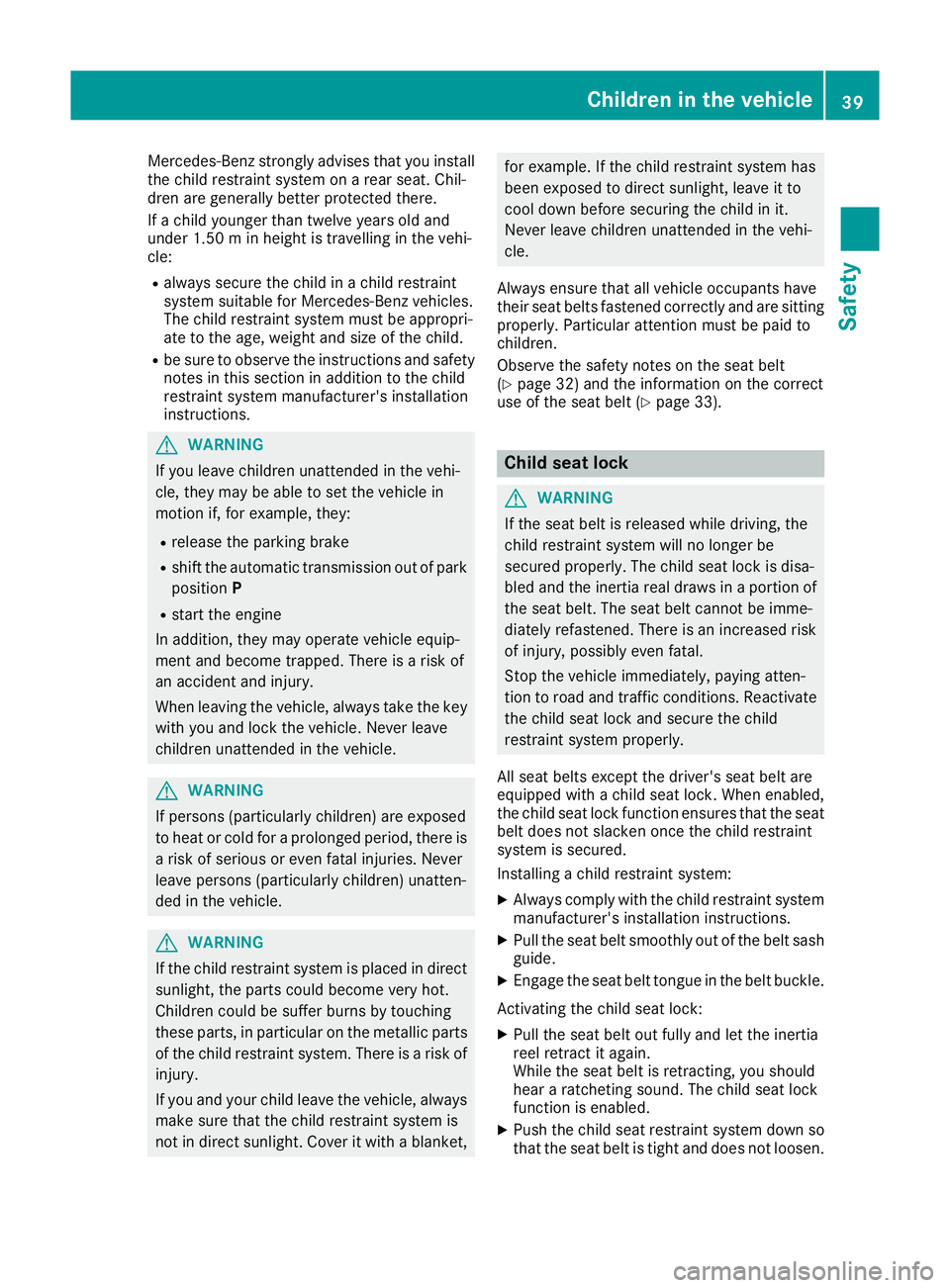
Mercedes-Ben
zstrongly advises that you install
the child restraint system on arear seat. Chil-
dren are generally better protected there.
If ac hild younger than twelve years old and
under 1.50 minh eight is travellin ginthe vehi-
cle:
R always secur ethe child in achild restraint
system suitable for Mercedes-Ben zvehicles.
The child restraint system must be appropri-
ate to the age, weight and size of the child.
R be sure to observe the instructions and safety
notes in this section in addition to the child
restraint system manufacturer' sinstallation
instructions. G
WARNING
If you leave children unattende dint he vehi-
cle, they may be abletos et the vehiclein
motion if, for example, they:
R release the parking brake
R shift the automatic transmission out of park
position P
R start the engine
In addition, they may operate vehicl eequip-
ment and become trapped. There is arisk of
an accident and injury.
When leaving the vehicle, alwayst ake the key
with you and lock the vehicle. Never leave
children unattended in the vehicle. G
WARNING
If persons (particularly children) are exposed
to heatorc old foraprolonged period, there is
ar isk of serious or even fatal injuries. Never
leave persons (particularly children) unatten-
ded in the vehicle. G
WARNING
If the child restraint system is placed in direct sunlight, the parts coul dbecome very hot.
Childre ncouldbes uffer burns by touching
these parts, in particular on the metallic parts
of the child restraint system. There is arisk of
injury.
If you and yourc hild leave the vehicle, always
make sure that the child restraint system is
not in direct sunlight. Cove ritwithablanket, for example. If the child restraint system has
been expose
dtodirect sunlight, leave it to
cool dow nbefore securing the child in it.
Never leave children unattende dinthe vehi-
cle.
Always ensure that all vehicl eoccupants have
their sea tbelts fastened correctly and are sitting
properly .Particular attention must be pai dto
children.
Observ ethe safety notes on the sea tbelt
(Y pag e32) and the information on the correct
use of the sea tbelt( Y pag e33). Chil
dseat lock G
WARNING
If th eseat beltisr eleased while driving, the
child restraint system willnol onger be
secure dproperly.T he child seat lock is disa-
bleda nd the inertia real draw sinaportion of
the seat belt. The seat beltc annot be imme-
diately refastened. There is an increased risk
of injury ,possibly even fatal.
Stop the vehicl eimmediately, paying atten-
tion to road and traffic conditions. Reactivate the child seat lock and secure the child
restraint system properly.
All seat belts except the driver's seat belta re
equipped with achild seat lock. When enabled,
the child seat lock function ensure sthat the seat
beltd oes not slacken once the child restraint
system is secured.
Installing achild restraint system:
X Always comply with the child restraint system
manufacturer's installation instructions.
X Pullt he seat belts moothly out of the belts ash
guide.
X Engage the seat beltt ongue in the beltbuckle.
Activating the child seat lock: X Pullt he seat belto ut fullyand let the inertia
reel retract it again.
Whil ethe seat beltisr etracting, you should
hear aratcheting sound .The child seat lock
function is enabled.
X Push the child seat restraint system downso
that the seat beltist ight and does not loosen. Children in the vehicle
39Safety Z
Page 43 of 261
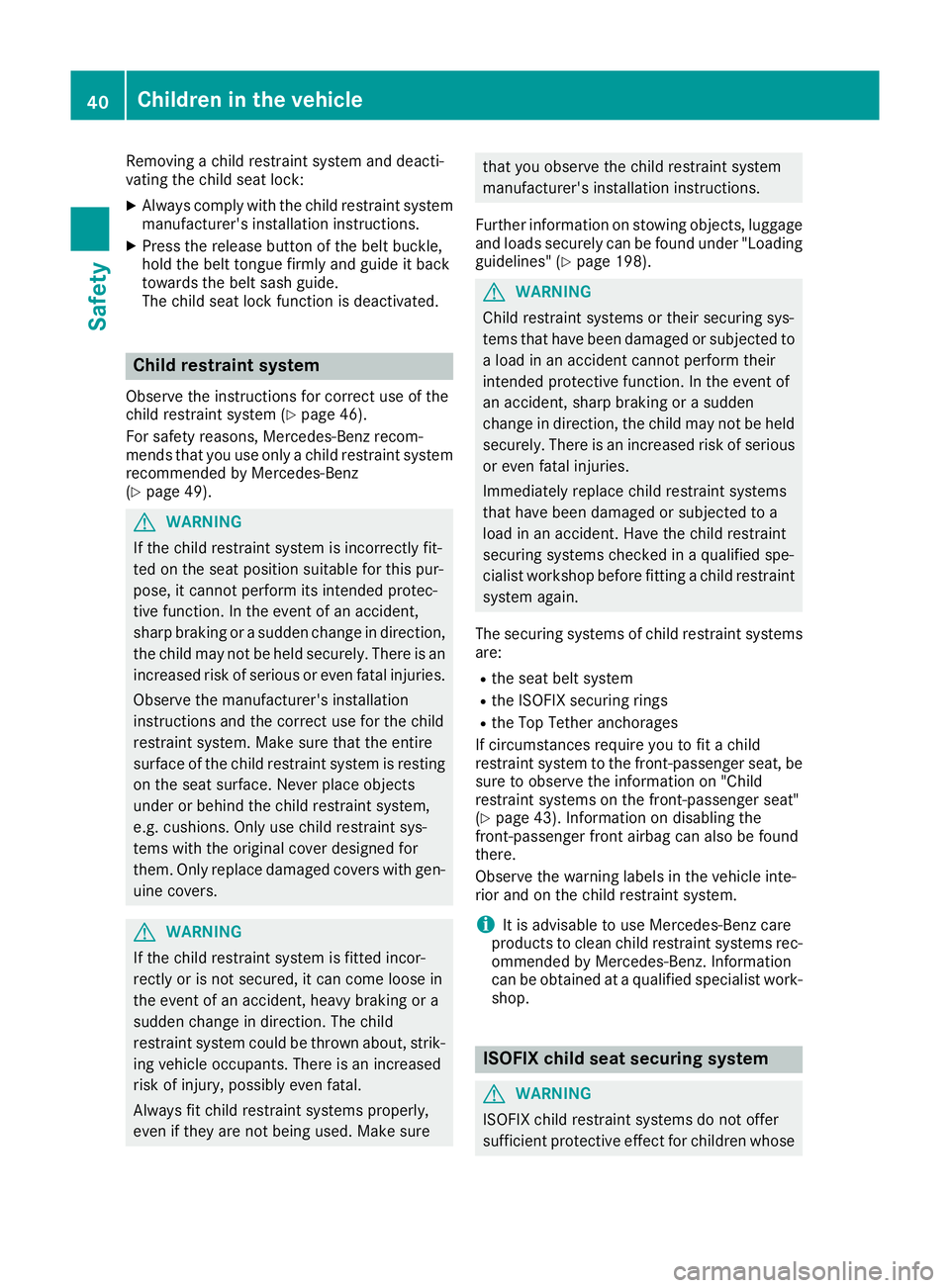
Removin
gachild restrain tsystem and deacti-
vating th echild seat lock:
X Always comply wit hthe child restrain tsystem
manufacturer' sinstallation instructions.
X Press th erelease butto nofthebelt buckle,
hold th ebelt tongue firmly and guide it back
towards th ebelt sash guide.
The child seat loc kfunction is deactivated. Child restraint system
Observ ethe instruction sfor correc tuse of the
child restraint system (Y page 46).
For safety reasons, Mercedes-Ben zrecom-
mends that you use only achild restraint system
recommended by Mercedes-Benz
(Y page 49). G
WARNING
If th echild restraint system is incorrectly fit-
ted on the seat position suitable for this pur-
pose ,itcannot perform its intended protec-
tive function. In the event of an accident,
sharp braking or asudden change in direction,
the child may not be held securely.T here is an
increased risk of serious or even fatal injuries.
Observe the manufacturer's installation
instructions and the correct use for the child
restraint system. Make sure that the entire
surface of the child restraint system is resting
on the seat surface. Never place objects
under or behind the child restraint system,
e.g. cushions. Only use child restraint sys-
tems with the original cover designed for
them. Only replace damaged covers with gen- uine covers. G
WARNING
If the child restraint system is fitted incor-
rectly or is not secured, it can come loos ein
the event of an accident, heavy braking or a
sudden change in direction. The child
restraint system coul dbethrown about, strik-
ing vehicl eoccupants. There is an increased
risk of injury ,possibly even fatal.
Always fit child restraint systems properly,
even if they are not being used .Make sure that you observe the child restraint system
manufacturer's installation instructions.
Further information on stowing objects, luggage and load ssecurel ycan be found under "Loading
guidelines" (Y page 198). G
WARNING
Child restraint systems or thei rsecuring sys-
tems that have been damaged or subjected to al oa dinana ccident cannot perform their
intended protective function. In the event of
an accident, sharp braking or asudden
change in direction, the child may not be held securely.T here is an increased risk of serious
or even fatal injuries.
Immediately replace child restraint systems
that have been damaged or subjected to a
loadinana ccident. Have the child restraint
securing systems checked in aqualified spe-
cialist worksho pbefore fitting achild restraint
system again.
The securing systems of child restraint systems
are:
R the seat belts ystem
R the ISOFIX securing rings
R the Top Tether anchorages
If circumstances require you to fit achild
restraint system to the front-passenge rseat, be
sure to observe the information on "Child
restraint systems on the front-passenge rseat"
(Y page4 3). Information on disabling the
front-passenge rfront airbag can alsobef ound
there.
Observe the warning labels in the vehicl einte-
rior and on the child restraint system.
i It is advisabl
etouse Mercedes-Benz care
products to clea nchild restraint systems rec-
ommended by Mercedes-Benz. Information
can be obtained at aqualified specialist work-
shop. ISOFIX chil
dseat securing system G
WARNING
ISOFIX chil drestraint systems do not offer
sufficient protective effect for children whose 40
Children in the vehicleSafety
Page 44 of 261
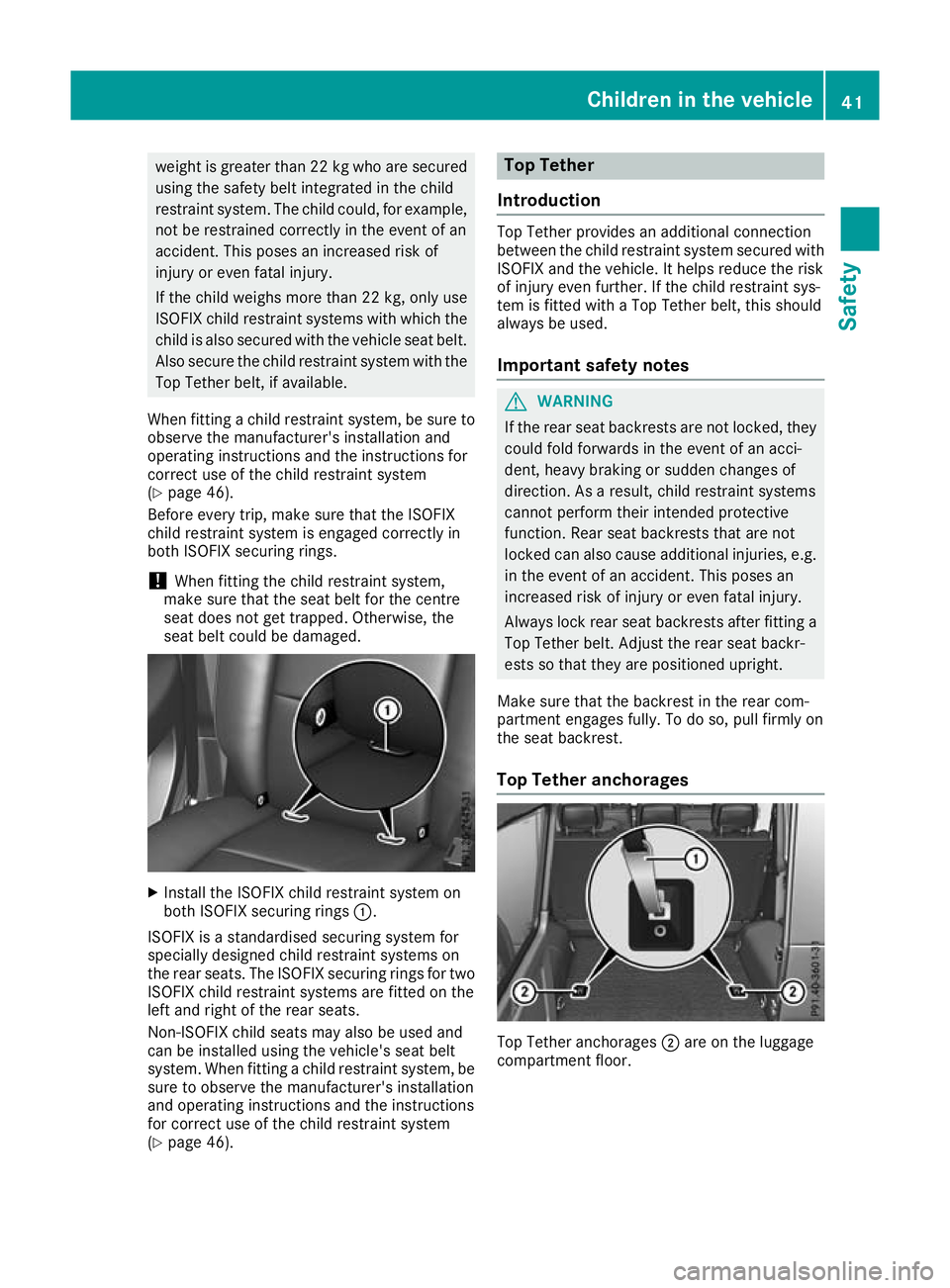
weight is greater than 22 kg who are secured
using th esafet ybelt integrated in th echild
restrain tsystem. The chil dcould, for example,
not be restrained correctly in th eeven tofan
accident. This poses an increase drisk of
injury or even fatal injury.
If th echildw eighs mor ethan2 2kg,only use
ISOFI Xchildr estrain tsystems with which the
chil disa lso secured with th evehicle seat belt.
Als osecure th echildr estrain tsystem with the
Top Tether belt ,ifavailable.
When fittin gachildr estrain tsystem, be sure to
observe th emanufacturer's installation and
operatin ginstructions and th einstructions for
correc tuse of th echildr estrain tsystem
(Y page 46).
Before ever ytrip, mak esure that th eISO FIX
chil drestrain tsystem is engaged correctly in
bot hISO FIXs ecurin grings.
! When fittin
gthe chil drestrain tsystem,
mak esure that th eseat belt for th ecentre
seat does not get trapped. Otherwise, the
seat belt could be damaged. X
Instal lthe ISOFIX child restraint system on
both ISOFIX securing rings :.
ISOFIX is astandardised securing system for
specially designed child restraint systems on
the rear seats. The ISOFIX securing rings for two ISOFIX child restraint systems are fitted on the
left and right of the rear seats.
Non-ISOFIX child seats may also be used and
can be installe dusing the vehicle's seat belt
system. When fitting achild restraint system, be
sure to observe the manufacturer's installation
and operating instructions and the instructions
for correct use of the child restraint system
(Y page 46). Top Tether
Introduction Top Tether provides an additional connection
betwee nthe child restraint system secured with
ISOFIX and the vehicle. It helps reduce the risk
of injury even further. If the child restraint sys-
tem is fitted with aTop Tether belt, this should
alway sbeu sed.
Important safety notes G
WARNING
If the rear seat backrests are not locked, they
could fold forwards in the event of an acci-
dent, heavy braking or sudden changes of
direction .Asaresult, child restraint systems
cannot perform their intended protective
function. Rears eat backrests that are not
locked can alsoc auseadditiona linjuries, e.g.
in the event of an accident. This poses an
increased risk of injury or even fatal injury.
Always lock rear seat backrests after fitting a Top Tether belt. Adjust the rear seat backr-
ests so that they are positioned upright.
Make sure that the backrest in the rear com-
partment engages fully. To do so, pullf irmly on
the seat backrest.
Top Tether anchorages Top Tethe
ranchorages ;are on the luggage
compartment floor. Children in the vehicle
41Safety Z
Page 45 of 261
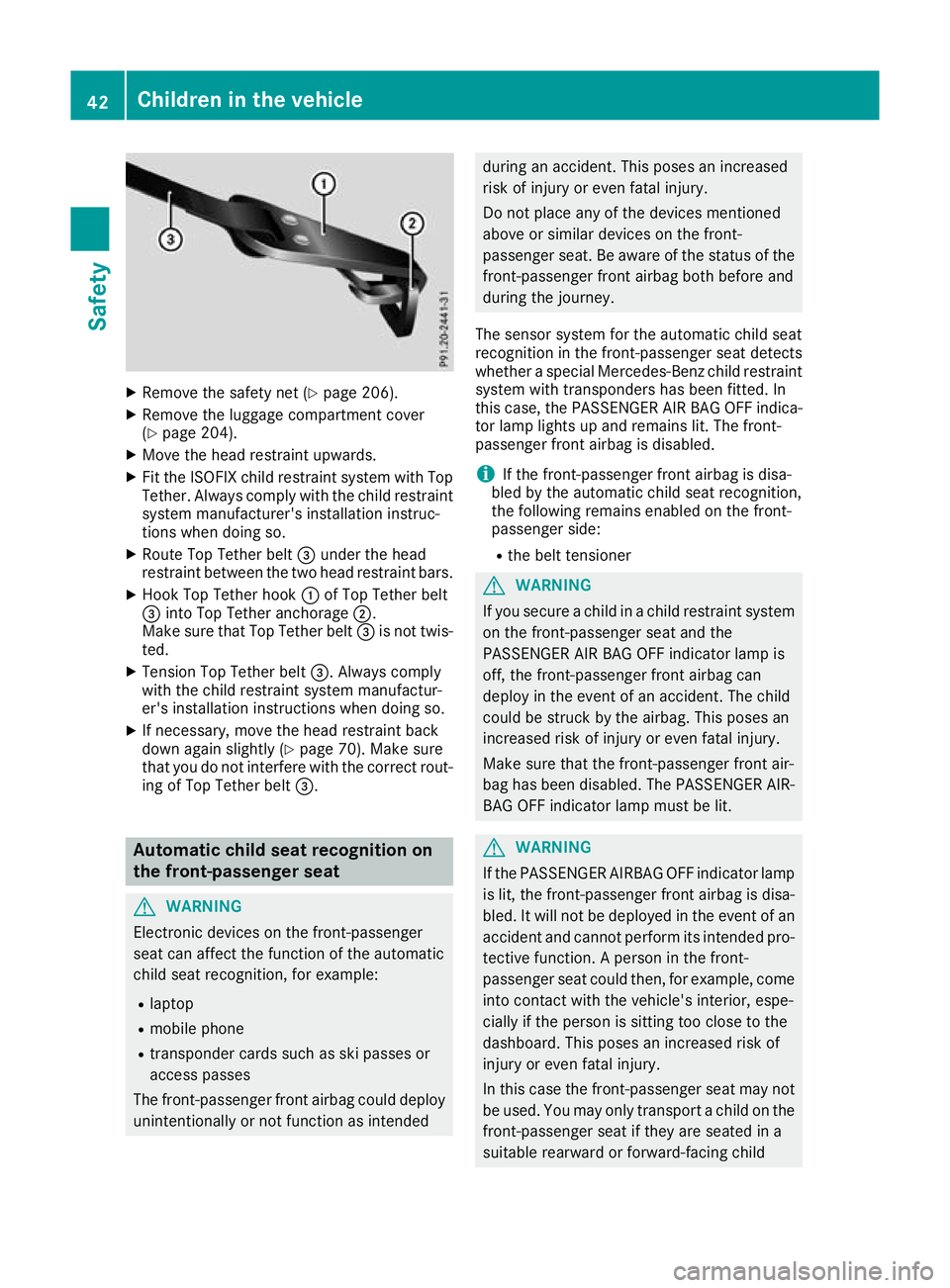
X
Remove th esafet ynet ( Ypage 206).
X Remove th eluggag ecom partmen tcover
(Y page 204).
X Mov ethe head restrain tupwards.
X Fit th eISOFI Xchild restrain tsystem wit hTop
Tether .Always comply wit hthe child restraint
system manufacturer' sinstallation instruc-
tion swhen doin gso.
X Rout eTop Tether belt =under th ehead
restrain tbetween th etwo head restrain tbars.
X Hook Top Tether hook :of Top Tether belt
= intoT op Tether anchorage ;.
Mak esuret hatT op Tether belt =is no ttwis-
ted.
X Tension Top Tether belt =.Always comply
wit hthe child restrain tsystem manufactur-
er' sinstallation instruction swhen doin gso.
X If necessary, mov ethe head restrain tback
down again slightly (Y page 70). Makesure
that you do no tinterfere wit hthe correc trout-
ing of Top Tether belt =.Automati
cchild sea trecognition on
th ef ront-passenger seat G
WARNING
Electronic device sonthe front-passenger
seat can affect the function of the automatic
child seat recognition, for example:
R laptop
R mobil ephone
R transponde rcards such as ski passes or
access passes
The front-passenge rfront airbag coul ddeploy
unintentionally or not function as intended during an accident. This pose
sanincreased
risk of injury or even fatal injury.
Do not place any of the devices mentioned
above or similar devices on the front-
passenger seat. Be aware of the status of the front-passenger fron tairbag both before and
during the journey.
The sensor system for the automatic child seat
recognition in the front-passenger seat detects
whether aspecial Mercedes-Benz child restraint
system with transponder shas been fitted. In
this case, the PASSENGER AIR BAGO FF indica-
tor lamp lights up and remains lit. The front-
passenger fron tairbag is disabled.
i If the front-passenger fron tairbag is disa-
bled by the automatic child seat recognition,
the following remains enabled on the front-
passenger side:
R the belt tensioner G
WARNING
If you secure achild in achild restraint system
on the front-passenge rseat and the
PASSENGER AIR BAG OFF indicator lamp is
off, the front-passenge rfront airbag can
deploy in the event of an accident. The child
coul dbes truck by the airbag. This poses an
increased risk of injury or even fatal injury.
Make sure that the front-passenge rfront air-
bag has been disabled. The PASSENGER AIR- BAG OFF indicator lamp must be lit. G
WARNING
If the PASSENGER AIRBAG OFF indicator lamp is lit, the front-passenge rfront airbag is disa-
bled. It willn ot be deployedint he event of an
accident and cannot perform its intended pro-
tective function. Aperso nint he front-
passenger seat coul dthen, for example, come
into contact with the vehicle's interior, espe-
cially if the perso nissitting too close to the
dashboard. This poses an increased risk of
injury or even fatal injury.
In this case the front-passenge rseat may not
be used .You may only transport achild on the
front-passenge rseat if they are seated in a
suitable rearward or forward-facing child 42
Children in the vehicleSafety
Page 46 of 261
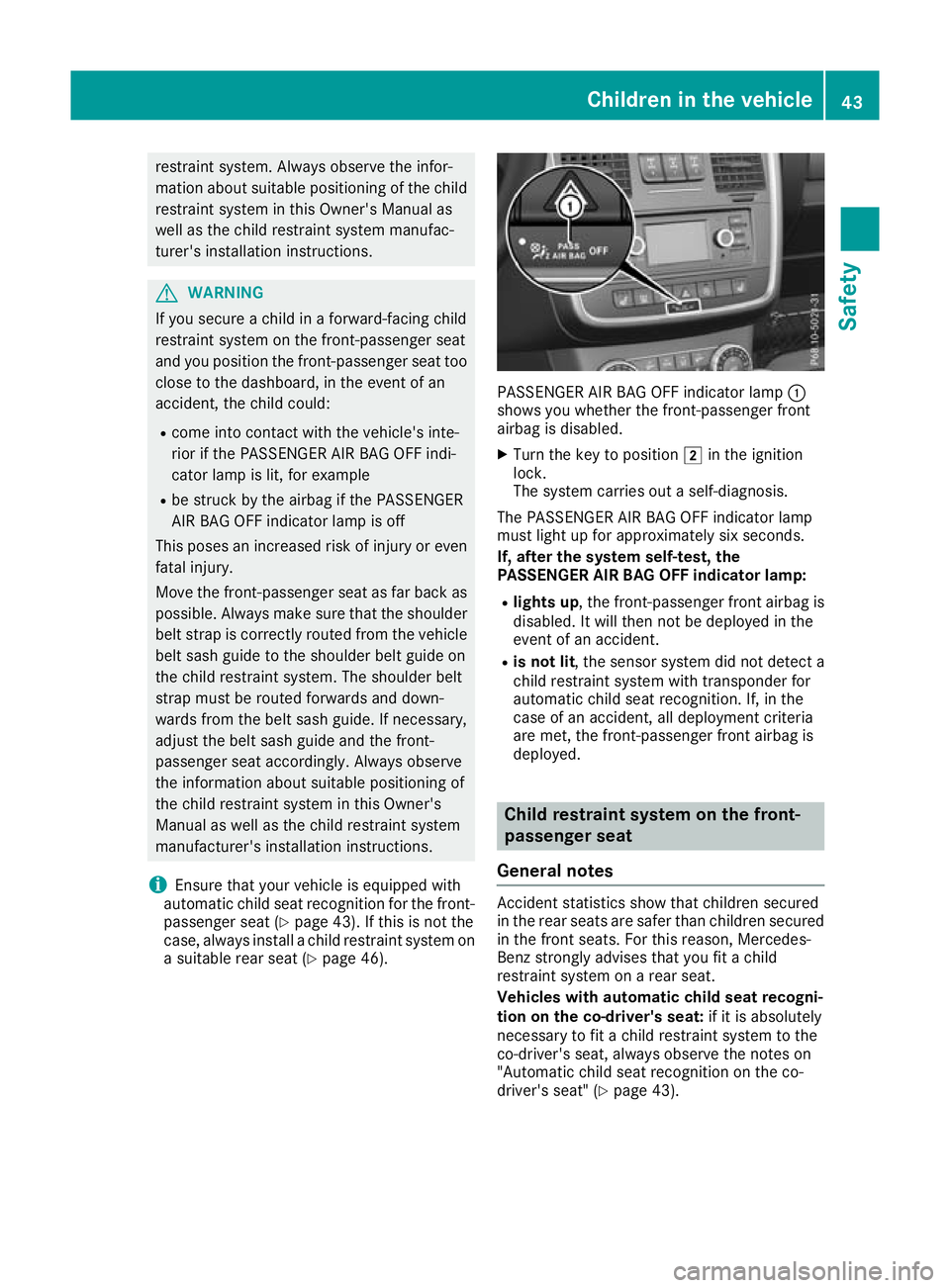
restraint system. Always observe the infor-
mation about suitable positioning of the child restraint system in this Owner's Manua las
wellast he child restraint system manufac-
turer's installation instructions. G
WARNING
If you secure achild in aforward-facing child
restraint system on the front-passenge rseat
and you position the front-passenge rseat too
close to the dashboard, in the event of an
accident, the child could:
R come into contact with the vehicle's inte-
rior if the PASSENGER AIR BAG OFF indi-
cator lamp is lit, for example
R be struck by the airbag if the PASSENGER
AIR BAG OFF indicator lamp is off
This poses an increased risk of injury or even fatal injury.
Move the front-passenge rseat as far back as
possible.A lways make sure that the shoulder
belts trap is correctly routed from the vehicle
belts ash guide to the shoulderb eltg uide on
the child restraint system. The shoulderb elt
strap must be routed forwards and down-
wards from the belts ash guide. If necessary,
adjust the belts ash guide and the front-
passenger seat accordingly .Always observe
the information about suitable positioning of
the child restraint system in this Owner's
Manual as wellast he child restraint system
manufacturer's installation instructions.
i Ensure that yourv
ehicleise quipped with
automatic child seat recognitio nfor the front-
passenger seat (Y page43).Ift his is not the
case, alwaysi nstallachild restraint system on
as uitable rear seat (Y page46). PASSENGER AIR BAG OFF indicato
rlamp :
shows you whether the front-passenger front
airbag is disabled.
X Turn the key to position 2in the ignition
lock.
The system carries out aself-diagnosis.
The PASSENGER AIR BAG OFF indicator lamp
must light up for approximately six seconds.
If, after the system self-test, the
PASSENGER AIR BAG OFF indicator lamp:
R lights up ,the front-passenger fronta irbag is
disabled. It will then not be deployed in the
event of an accident.
R is not lit ,the sensor system did not detect a
child restraint system with transponder for
automatic child seat recognition. If, in the
case of an accident ,all deployment criteria
are met, the front-passenger fronta irbag is
deployed. Childr
estraint system on th efront-
passenge rseat
General notes Accident statistics show that childre
nsecured
in the rea rseats ar esafer tha nchildren secured
in the front seats. For thi sreason, Mercedes-
Benz strongl yadvises tha tyou fitac hild
restraint system on arears eat.
Vehicles with automatic child seat recogni-
tio nont he co-driver' sseat:if it is absolutely
necessary to fit achild restraint system to the
co-driver' sseat, always observe the notes on
"Automatic child sea trecognitio nonthe co-
driver's seat" (Y page 43). Child
renint hevehicle
43Safety Z
Page 47 of 261
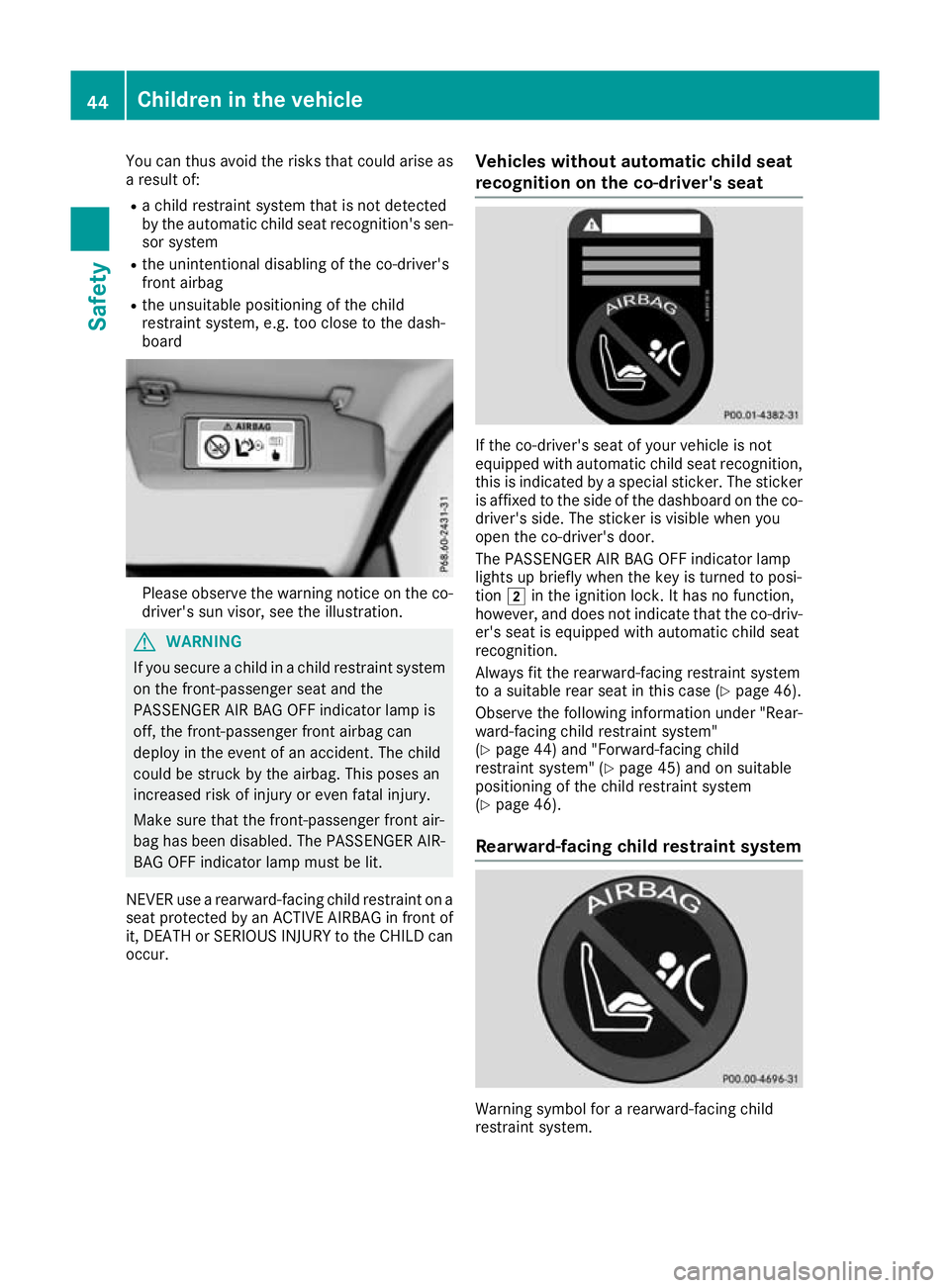
You can thus avoid the risk
sthat could arise as
ar esult of:
R ac hild restraint syste mthat is not detected
by the automatic child seat recognition' ssen-
sor system
R the unintentional disabling of the co-driver's
fron tairbag
R the unsuitable positionin gofthe child
restraint system, e.g. too close to the dash-
board Please observe the warning notice on the co-
driver' ssun visor, see the illustration. G
WARNING
If you secure achild in achild restraint system
on the front-passenge rseat and the
PASSENGER AIR BAG OFF indicator lamp is
off, the front-passenge rfront airbag can
deploy in the event of an accident. The child
coul dbes truck by the airbag. This poses an
increased risk of injury or even fatal injury.
Make sure that the front-passenge rfront air-
bag has been disabled. The PASSENGER AIR- BAG OFF indicator lamp must be lit.
NEVER use arearward-facing child restraint on a
seat protected by an ACTIVE AIRBAG in front of
it, DEATH or SERIOUS INJUR Ytothe CHILD can
occur. Vehicles without automatic child seat
recognitio nonthe co-driver' sseat If th
eco-driver's seat of yourv ehicle is not
equipped with automatic child seat recognition,
this is indicated by aspecia lsticker. The sticker
is affixed to the side of the dashboard on the co-
driver's side. The sticker is visible when you
open the co-driver's door.
The PASSENGER AIR BAG OFF indicator lamp
lights up briefl ywhen the key is turned to posi-
tion 2in the ignition lock. It has no function,
however, and does not indicate that the co-driv-
er's seat is equipped with automatic child seat
recognition.
Alwaysf it the rearward-facing restraint system
to as uitable rear seat in this case (Y page 46).
Observe the following information under "Rear-
ward-facing child restraint system"
(Y page 44) and "Forward-facing child
restraint system" (Y page 45) and on suitable
positioning of the child restraint system
(Y page 46).
Rearward-facing childr estraint system Warning symbo
lfor arearward-facing child
restraint system. 44
Children in the vehicleSafety
Page 48 of 261
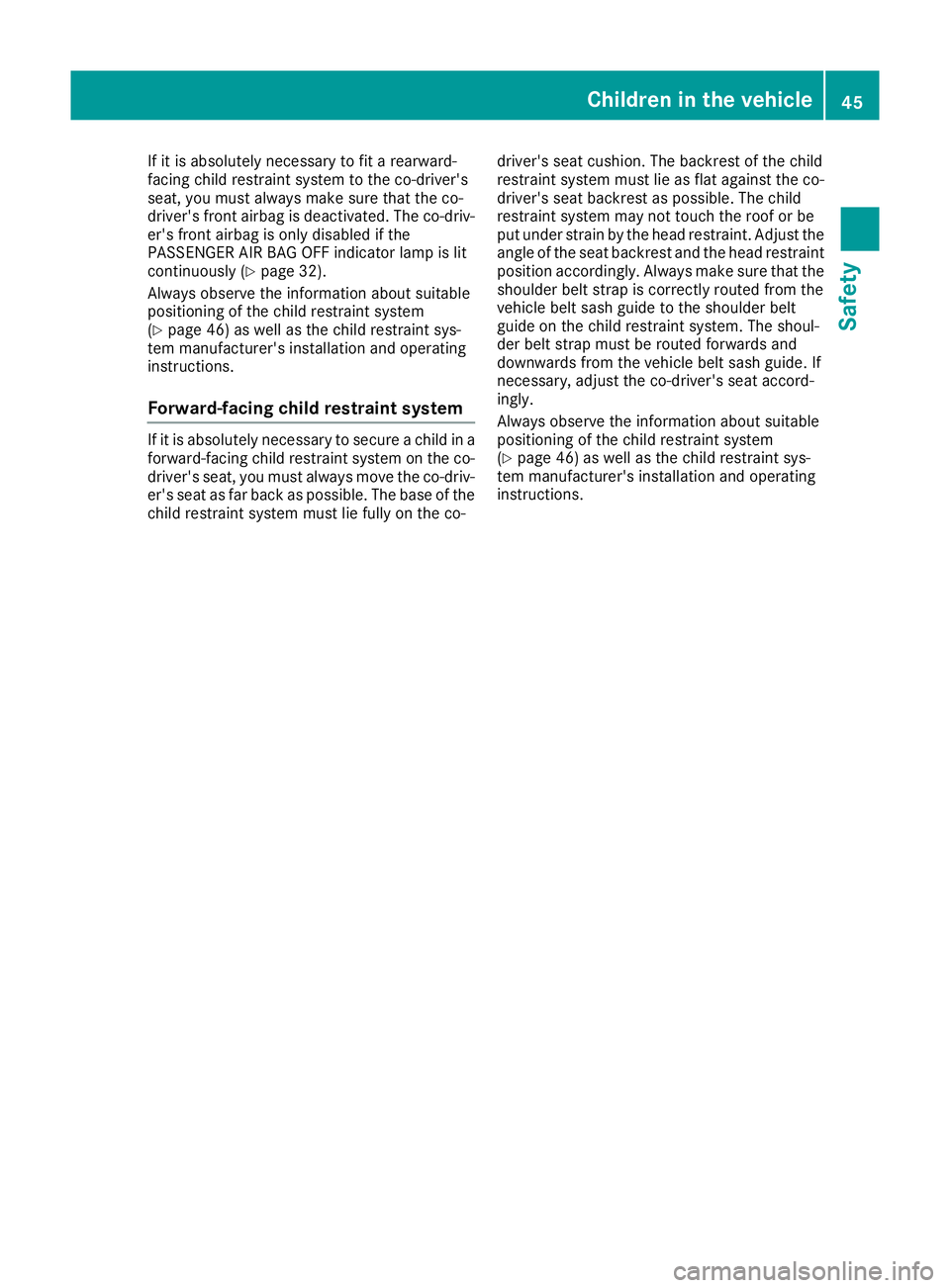
If it is absolutely necessary to fit
arearward-
facing child restraint system to the co-driver's
seat, you must always make sure that the co-
driver's front airbag is deactivated. The co-driv-
er's front airbag is only disabled if the
PASSENGER AIR BAG OFF indicator lamp is lit
continuously (Y page 32).
Alwayso bserve the information abouts uitable
positioning of the child restraint system
(Y page 46) as well as the child restraint sys-
tem manufacturer's installation and operating
instructions.
Forward-facingc hildr estraint system If it is absolutely necessary to secure
achild in a
forward-facing child restraint system on the co- driver's seat, you must always move the co-driv-
er's seat as far back as possible. The base of the child restraint system must lie fullyont he co-driver's seat cushion. The backrest of the child
restraint system must lie as flat against the co-
driver's seat backrest as possible.T
he child
restraint system may not touch the roof or be
put under strain by the head restraint .Adjust the
angle of the seat backrest and the head restraint position accordingly. Always make sure that the
shoulder belt strap is correctly routed from the
vehicle belt sash guide to the shoulder belt
guide on the child restraint system. The shoul-
der belt strap must be routed forwards and
downwards from the vehicle belt sash guide. If
necessary, adjust the co-driver' sseat accord-
ingly.
Always observe the information about suitable
positioning of the child restraint system
(Y page 46) as well as the child restraint sys-
tem manufacturer's installation and operating
instructions. Children in thev
ehicle
45Safety Z
Page 49 of 261
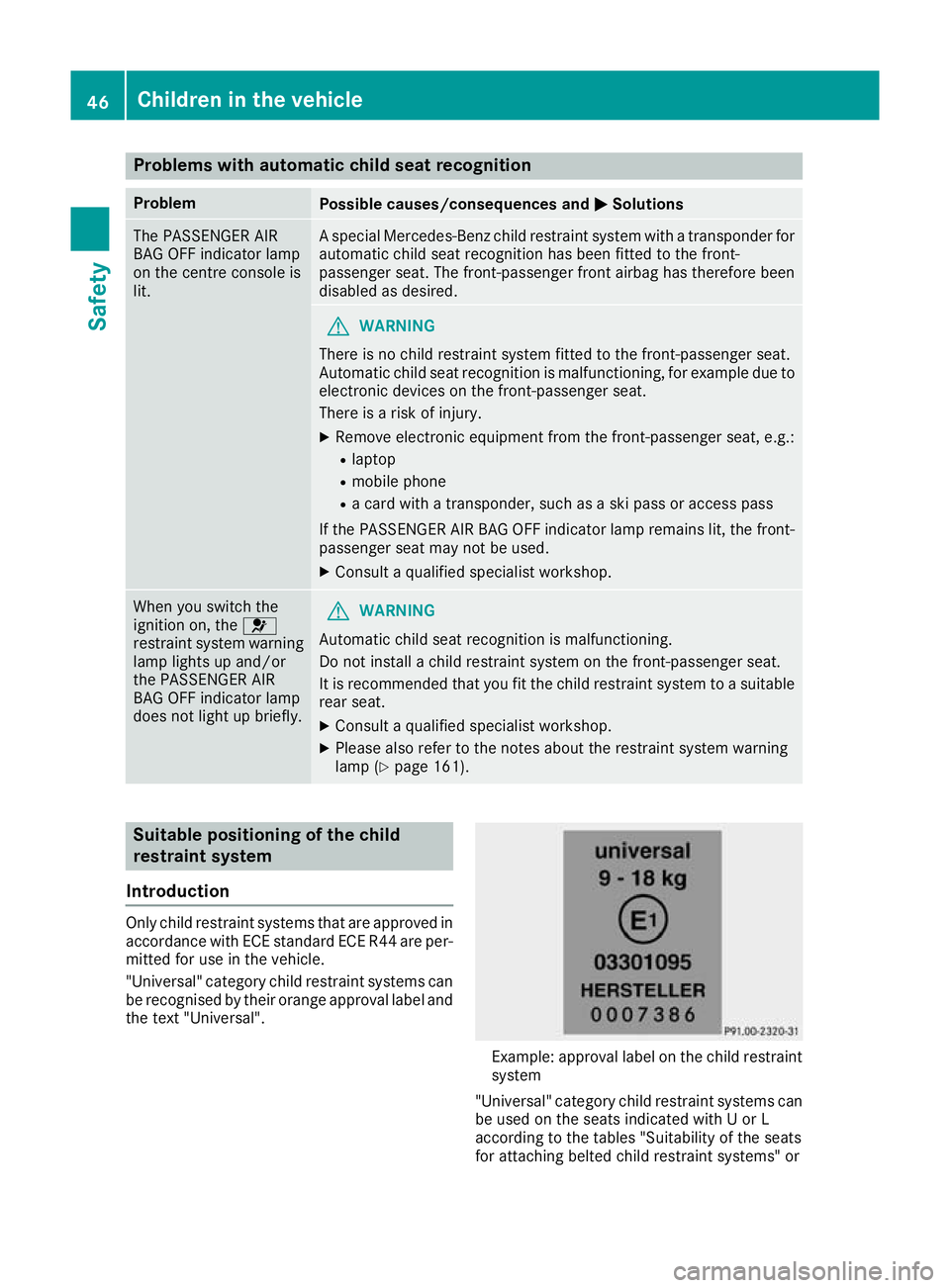
Problems with automatic child seat recognition
Problem
Possible causes/consequences and
M
MSolutions The PASSENGER AIR
BAG OFF indicator lamp
on the centre console is
lit. As
pecia lMercedes-Benz child restraint system with atransponde rfor
automatic child sea trecognitio nhasbeen fitte dtothe front-
passenge rseat. The front-passenger front airba ghastherefore been
disabled as desired. G
WARNING
There is no child restraint syste mfitted to the front-passenge rseat.
Automatic child seat recognitio nismalfunctioning, for exampl edue to
electronic devices on the front-passenge rseat.
There is arisk of injury.
X Remove electroni cequipment from the front-passenge rseat, e.g.:
R laptop
R mobil ephone
R ac ard with atransponder, such as aski pass or access pass
If the PASSENGER AIR BAG OFF indicator lamp remains lit, the front- passenger seat may not be used.
X Consult aqualified specialist workshop. When you switch the
ignition on, the
6
restraint system warning lamp lights up and/or
the PASSENGER AIR
BAG OFF indicato rlamp
does not light up briefly. G
WARNING
Automati cchild seat recognitio nismalfunctioning.
Do not install achild restraint system on the front-passenge rseat.
It is recommende dthat you fit the child restraint system to asuitable
rear seat.
X Consult aqualified specialist workshop.
X Please alsor efer to the notes about the restraint system warning
lamp (Y page161). Suitable positioningoft
he child
restraint system
Introduction Only child restraint systems that are approved in
accordance with ECE standard ECE R44 are per-
mitted for use in the vehicle.
"Universal" category child restraint systems can
be recognised by their orange approval label and
the text "Universal". Example: approval label on the child restraint
system
"Universal "category child restraint system scan
be used on the seats indicated with UorL
according to the table s"Suitability of the seats
for attaching belte dchild restraint systems" or 46
Children in the vehicleSafety
Page 50 of 261
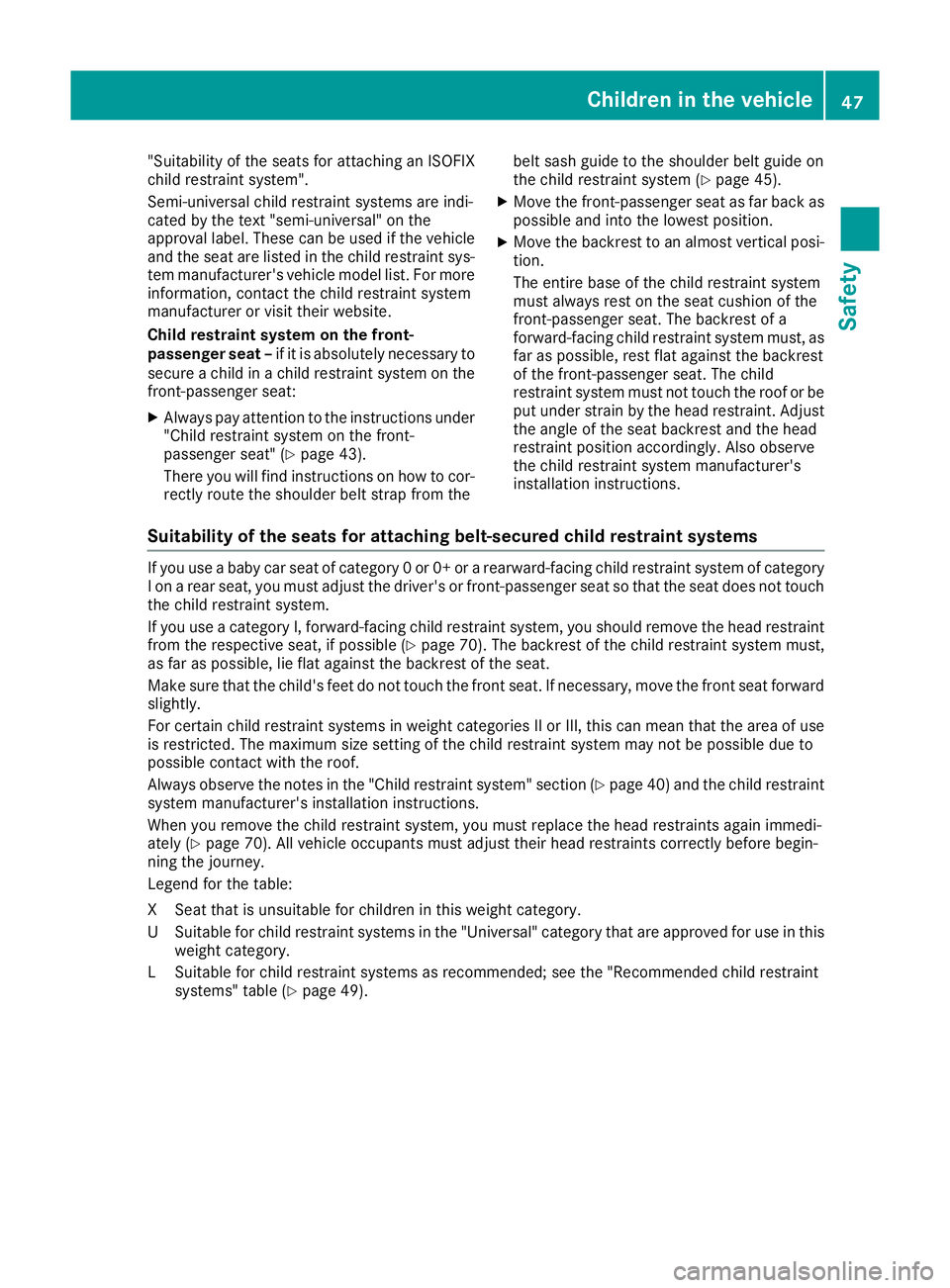
"Suitabilit
yoftheseat sfor attaching an ISOFIX
child restraint system".
Semi-universal child restraint systems are indi-
cated by th etext"semi-universal" on the
approval label. Thes ecan be used if th evehicle
and th eseat are listed in th echild restraint sys-
te mm anufacturer' svehicle model list .For more
information, contact th echild restraint system
manufacturer or visit their website.
Child restrain tsystem on th efront-
passenger seat – if it is absolutely necessary to
secure achild in achild restraint system on the
front-passenger seat:
X Always pay attentio ntotheinstruction sunder
"Child restraint system on th efront-
passenger seat "(Ypage 43).
Ther eyou will fin dinstruction sonhow to cor-
rectly rout ethe shoulder belt strap from the belt sash guide to the shoulder belt guide on
the child restraint syste
m(Ypage 45).
X Move the front-passenger seat as far back as
possible and int othe lowest position.
X Move the backrest to an almost vertical posi-
tion.
The entire base of the child restraint system
must always rest on the seat cushion of the
front-passenger seat. The backrest of a
forward-facin gchild restraint system must, as
far as possible, rest flat against the backrest
of the front-passenger seat. The child
restraint system must not touch the roof or be
put under strain by the head restraint .Adjust
the angle of the seat backrest and the head
restraint position accordingly. Also observe
the child restraint system manufacturer's
installation instructions.
Suitability of the seats for attaching belt-secured child restraint systems If you use
ababy car seat of category 0or0+orarearward-facing child restraint system of category
Ionar ear seat, you must adjust the driver's or front-passenger seat so that the seat does not touch
the child restraint system.
If you use acategory I, forward-facing child restraint system, you shouldr emove the head restraint
from the respective seat, if possible (Y page 70). The backrest of the child restraint system must,
as far as possible, lie flat against the backrest of the seat.
Make sure that the child's feet do not touch the front seat. If necessary ,move the front seat forward
slightly.
For certain child restraint systems in weight categories II or III, this can mean that the area of use
is restricted. The maximum size setting of the child restraint system may not be possible due to
possible contact with the roof.
Alwayso bserve the notes in the "Child restraint system" section (Y page 40) and the child restraint
system manufacturer's installation instructions.
When you remove the child restraint system, you must replace the head restraints again immedi-
ately (Y page 70). All vehicle occupants must adjust their head restraints correctly before begin-
ning the journey.
Legend for the table:
XS eat that is unsuitable for children in this weight category.
US uitable for child restraint systems in th e"Universal" categor ytha ta re approve dfor use in this
weigh tcategory.
LS uitable for child restraint systems as recommended; see th e"Recommended child restraint
systems "table (Y page 49). Children in th
evehicle
47Safety Z